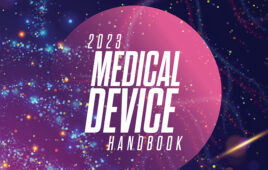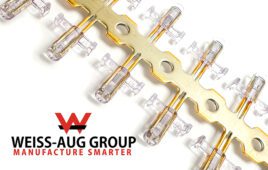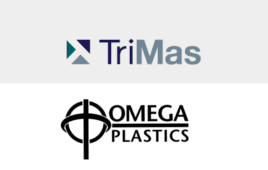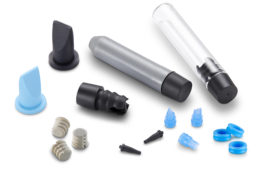
Brian Matachun |
Director of Technical Sales |
MTD Micro Molding |
The smallest parts often carry the greatest importance relative to the functionality and safety of a medical device. MTD Micro Molding refers to its micro molding tools – its road map to success, if you will – as the company’s “6 Sciences.” Embracing this approach can yield better long-term results, both with part functionality and speed to market and, most importantly, solve the problems faced trying to manufacture a micro component with traditional molding techniques.
1) Micro materials
Select the right materials for the application. Material selection has a direct impact on the outcome of a project – it drives tolerance, dimension, strength, usability, design, speed-to-market, critical features and cost. When working with a range of thermoplastic and bioresorbable materials, it’s important to find the most appropriate material to yield the best results for the intended application. Experienced medical micromolders have the tools to characterize several materials to determine the best material for the component application.

MTD Micro Molding’s “6 sciences of micro molding” approach decreases potential issues faced when micromolding a part. These tiny molds hold great responsibility in a medical device design.
2) Micro part design
What micro part design is feasible? Understanding what can be created in steel versus what can be manufactured in production volume is the key to being successful. In addition to a part’s reproducibility, consider the required features:
• Does the design have wall stocks in the range of 0.002 in. to 0.004 in.?
• Does it have aspect ratios in the range of 250:1?
• Is the part weight so low that 520 parts could be made from a single pellet of plastic?
Each of these features can be accomplished by micromolding and are generally recognized by the industry as features that require highly specialized tools. One of the greatest myths in the medical device industry, however, is that a part needs to be microscopic to be considered a micro part – this is not the case.

MTD’s Ultra-precision micro inserts are the result of exact tooling execution.
In many instances, microscopic features on a larger part (1 in. x 1 in. max part size) require more specialized tools and techniques than are needed to create a microscopic part with a simpler geometry. In fact, some of the most difficult parts to manufacture are larger parts with micro features. Three micro technology tools are available to optimize micro part design:
- MicroFill – Using a spiral mold at a selected melt temperature, the material’s shear sensitivity can be determined.
- MicroFlow – Determine realistic wall thicknesses for certain materials by running multiple injection velocities while measuring flow length.
- MicroRunner – Determine minimum runner size required to fill the volume of your part, with the goal of sizing a runner system to adequately mold a product without unnecessarily sacrificing material. This tool is particularly important when working with expensive materials.
These technologies, coupled with extreme material conditioning control, allow conventional micro runner systems to produce 10,000 shots per pound of material. If there is a struggle to maintain consistency, the importance of controlling these factors may not be understood or practiced by the micromolder.
3) Micro tooling
A successful micromolded component starts with an exact mold – the advanced workpiece accuracy target should near 42 millionths. At MTD, workpiece accuracy is defined as what the actual molded part looks like when it comes out of the machine, not what the machine itself is designed to do. A medical device OEM and molding partner might share the same plan going in, but exact execution makes all of the difference.
3D EDM milling machines are unique pieces of tooling equipment that enable extremely detailed cavity geometry in micromolding by following a tool path similar to CNC milling. The major difference is that the end mill is actually an electrode that can be as small as 5µ – just imagine the crispness of the geometry.
4) Micro molding
Once the mold is built, it’s important to perform installation qualification on the technologically advanced micromolding cell. It is vital to ensure that the mold is functioning properly when mounted into the press.
Dependable and accurate equipment is essential when working with such small numbers. The plunger resolution of a micromolding machine can be compared to a human hair: 25% of the diameter of a human hair on position is the difference between a full shot, a short shot, or a flashed shot.
With in-line inspection systems, micromolders can verify the absence or presence of details down to 0.0001 in., providing peace of mind that every part is 100% correct.
Other lines of defense include process monitoring and control systems for plastic injection molding applications, which speed the visual inspection process and can tighten the window on how a cavity is packed, help sort good from bad, and predict dimensions.

A shot of various micromolded parts sitting atop a dime show the complexity and precision of the micromolding process.
5) Micro metrology
Although each micro-manufacturing cell is considered autonomous, quality assurance techniques must be depended on in micromolding, in the form of micro metrology and testing. Because of the typical part size and tight tolerances of medical micro parts, it’s important that a molder’s processes and tools focus on perfecting the measurement system early in a project. Custom measurement fixtures and non-contact, optical vision systems should be created and validated for each part. Measurement systems should be validated for inspecting all critical dimensions with a passing gauge repeatability and reproducibility (gauge R&R), ensuring that the data is valid and captured with accuracy which can be extremely challenging to accomplish with ultra-tight tolerances (i.e. +/-0.001 in.).
A note about GR&Rs: The goal of a gauge R&R is not to determine if parts are within specification. It tells whether a measurement system can accurately and consistently measure your parts.
6) Micro packaging
Handling, assembling and packaging micro-sized parts is far more challenging, and the solutions far different, than for macro-sized parts. Every machine should have a custom end-of-arm tool for each molded part. That way, the critical parts are always handled and packaged with extreme care and precision and no parts are simply ejected into a bin.




